abstract
The TPS2393A is a hot-swap controller designed for -48V systems. It is widely used in various applications due to its advanced features, such as wide input voltage range, programmable current limit, UV/OV protection, insertion detection, power good indication, and alarm functionality. The device also includes load current slew rate control and peak current limiting, which help manage surge loads effectively.
Under normal conditions, the actual load current is kept below the safety margin threshold. However, in some cases, higher rated currents are required, which can place significant stress on the FETs used for inrush current control. For example, in a system requiring 10A at -48V, the initial current might be limited to 10A (480W), causing high VDS across the FET. This makes FET selection challenging due to thermal and power dissipation constraints.
This article introduces a simple and effective method to extend the application scope of the TPS2393A, allowing it to handle higher load currents without compromising performance or reliability.
introduction
The TPS2393A is a comprehensive -48V hot-swap power management IC that uses an external N-channel power FET and a low-value current-sense resistor to control load power-up. It limits the load current to a reference value using a linear amplifier (LCA). The reference voltage is set to 40mV, and the maximum load current is determined by this value. Figures 1 and 2 show the block diagram and ramp generator module of the TPS2393A, respectively.
The value obtained is IMAX, the maximum load current.

Figure 1: TPS2393 current control loop

Figure 2: Ramp generator module
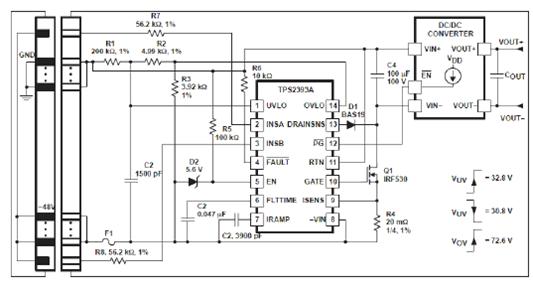
Figure 3: Typical hot swap diagram
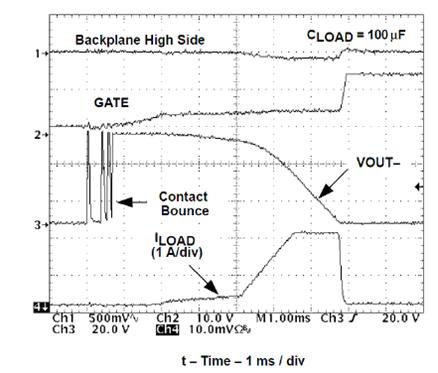
Figure 4: TPS2393 waveform
Please note: VOUT represents the drain voltage of the FET. At T = 0, VDS is approximately 48V. When the FET turns on, VDS drops close to zero. Contact flickering indicates hot plug or board insertion events. After insertion, the voltage swings up to 48V, and the gate begins switching, allowing current into the board while VDS decreases and IDS increases.
Achieve heavy load hot swap
To avoid exceeding the FET’s safe operating area (SOA) curve during inrush current, the maximum current must be limited to a reasonable level. For example, if the typical charging current for bulk capacitors is 2A (40mV/20mΩ), the actual load current should be less than 2A. However, some applications require higher load currents, ranging from 5A to 50A, which demands a very low RSNS value to allow higher current limits. This increases the challenge of selecting the right FET.
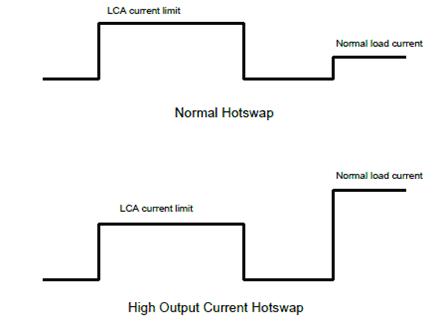
Figure 5: Different ideal current waveforms required
Assuming a normal load current of 10A, with a sense resistor RSNS less than 4mΩ, the FET must have a low RDSOn. For example, FDB047N10 has Rdson = 4.7mΩ and Rθja = 62.5°C/W. At ambient temperature TA=40°C, the junction temperature calculation shows no steady-state issues. However, the SOA curve must be considered for transient power dissipation during startup.
In Figure 5, the FDB047N10 can support 10A constant current for less than 1ms but can handle 2A for about 10ms. A trade-off between reliability and charging time must be made when choosing the current level.
Also, keep in mind that the SOA curve in the FET data sheet is based on a 25°C ambient case temperature. In real-world applications, higher ambient temperatures may require derating. The TI application note "Using the TPS2490/91 Hot-Swap Design and Transient Thermal Response of FETs" is a helpful resource.
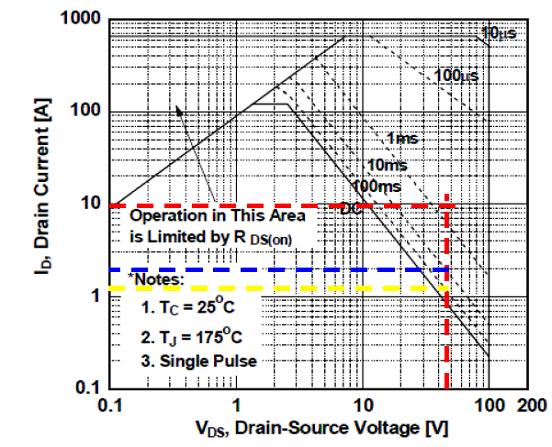
Figure 6: FDB047N10 SOA curve
A simple way to meet high output current hot swap requirements is to isolate the LCA current limit threshold from the overcurrent (OC) limit threshold. Although these are integrated in the TPS2393A, the /PG signal can be used to adjust the bypass FET's current level under different conditions.

Figure 7: Schematic view of bias current adjustment
Since the ISENS pin is connected to the negative side of the LCA (set to 40mV), we can derive the following equation:

Simplifying Io gives:

With R1 = R2 = 470kΩ, R3 = 680Ω, and R4 = 4mΩ, the initial load current Io ≈ 1.3A. From the SOA curve, the maximum SOA time for 1.3A is around 100ms.
Assuming CLoad = 100μF, the minimum charging time is calculated as follows:

The TPS2393A allows programming the "surge slew rate" via a capacitor on the IRAMP pin, increasing the actual charging time. This ensures the FET remains within the SOA during startup.
The TPS2393A also includes a programmable "fault timer" to protect the FET. Based on previous analysis, the fault timer can be set between 3.7ms and 100ms. The timer capacitor can be calculated using the following equation:
Figure 7 shows the startup waveform tested on the EVM board.
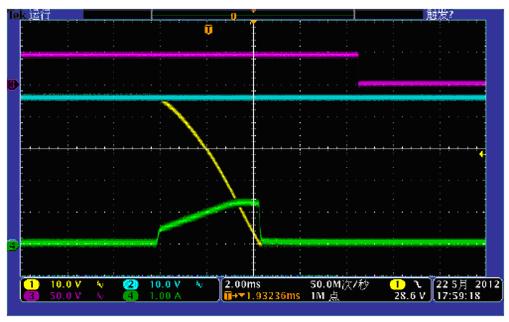
Figure 8: Bias current start
Once the startup process completes, the /PG signal goes low. The bias current through R2 becomes negligible, and the maximum load current rises to:

Since R1 is directly connected to the bus voltage, the bias current varies with the bus voltage. If the bus voltage range is wide, an external circuit can be added to provide a fixed reference voltage to R1, ensuring a stable bias current.
in conclusion
Despite the relatively low current limit threshold of the TPS2393A, it can support a broader range of applications if the steady-state load current exceeds the startup charge current. This article presents a method to adjust the current limit at different operational stages—from rising to stable—enhancing the device's versatility.
references
1. TI SLUS536C "TPS2393A Product Manual"
2. "Using the TPS2393 -48V ATCA module hot swap", by Jim Bird, TI SLUA318
3. "Full Featured -48V Hot Swap Power Manager (TPS2392 and TPS2393)", by Andy Ripanti, TI
4. "Using TPS2490/91 hot-swap FET transient heat dissipation design and response", by Martin Patoka, TI
5. "FDB047N10 Product Manual", Fairchild Semiconductor Corporation
12V Lithium Battery,Customized lithium battery pack for drone,Lithium Cell Batteries,lithium converged batteries
Shenzhen Jentc Technology Co., LTD , https://www.phenyee.com